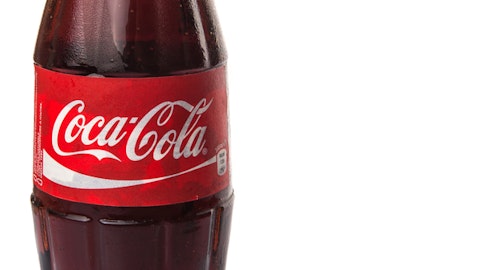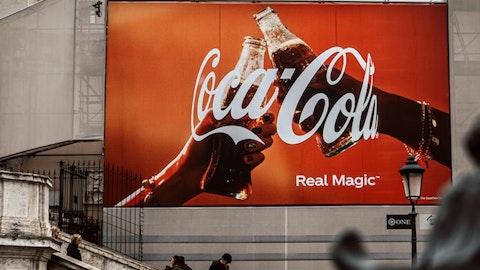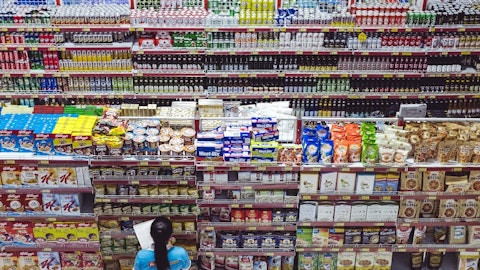So that basically leaves at least the cash we have on hand in the balance sheet right now available and again, cash is fungible, but — but in that amount of the cash that we have right now for inorganic expansion and for capital returns to shareholders. So we faced, I think, with a very high cost problem of having, I mean, two very cash-generative assets at very attractive reinvestment opportunities in cash flow generation. We have one, a burgeoning business, not burgeoning, but I mean, incubating business, which is digital, which we are investing in, but it only consumes a fraction of the cash that the other two businesses are speeding off and that provides us, again, optionality to look for value-creating acquisitions and potentially, I mean, substantial returns to shareholders as well.
Ben Theurer: Thank you.
Operator: The next question comes from the line of Bob Ford from Bank of America. Please go ahead.
Bob Ford: Thank you. Good morning everybody and thanks for taking the question. You seem to be generating not only scale, but engagement with premia. Could you talk a little bit in terms of where you are in terms of driving frequency and average ticket and where you are in that progression of transitioning premia a cost to a profit center, please?
Juan Fonseca: Hey Bob. This is Juan. I think you focus on something that I find very exciting myself, which is the speed at which premia has grown, the massive number of users, and when we look internally at the impact on average ticket. So how this is spilling over to the auto business, but also very early stages where we are working with partners, right? So you talk about Volaris, you talked about Volaris — the streaming service from Televisa and potentially others that may come down the road as well as the internal ones. OXXO Gas, in particular, you noticed the power of this in a demographic that historically has not really had a lot of access to loyalty programs. So there is — the average ticket that goes to Premia is meaningfully higher than the regular average ticket.
You start really looking at things like retail media, digital media, where you begin to monetize when you get on your app to check your point, balance or whatever, and you begin to get ads by some of our big suppliers. So you’re transferring the real estate obviously, for a long time, we’ve been monetizing the physical real estate on the commercial income front, but we’re beginning to monetize the digital real estate for similar purposes, which, of course, is endless. So very early stages, but moving in the right direction and probably a little bit faster than I expected.
Eugenio Garza: Yes. And Bob, if I may, just to add a couple of points to that. The most exciting part of the OXXO Premia is the fact that we are being able to identify the different journeys from different consumer segments. And the fact is that there is one way in which a consumer that goes into an OXXO Gas station and accumulate points there, uses the overall ultrapremian platform versus someone that goes and use daily to buy a coffee in an office store. And the reality is that the team is digging into every single journey possibility so that they maximize the personalization for consumers in the midterm. That’s really the end game here on top of everything else that Juan said. So today, when you look at the tender, which is very high already, that already reflects the fact that consumers are themselves learning how to use their point, how to use the ecosystem.
And it has to do with a bunch of things related to the consumer. It has to do with the age group they belong to, the economic level they belong to, the type of light they have, whether they are a student or they are a young professional or they are a professional driving an Uber or a truck. And all those journeys are allowing us understanding them is what is allowing the team to actually tailor made some of the activities that are conducted promotions with up store, promotions with OXXO Gas, promotions with the partners. And really, that is the exciting part of all this beyond the number of active users that we have, which is really big too. So honestly, moving forward there are a lot of possibilities that are being — that the team is tapping into, that are part of what is included once again, as I said before, in the long range planning.
And I’m sure that we’ll be able to share more on what is happening in digital more in detail in the months to come.
Eugenio Garza: Yeah. And I think the other thing that is beginning to accumulate Bob, is the amount of data, right? I mean to Paco’s point, we are being able to gather and obviously, for the first time, had the data assigned to a person for whom we know. Who are they? What is their email account? What is their phone number? And then begin to customize some of this promotional activity and incentivize behaviors with the rewards themselves. So, early stages for all of this got off to a faster start than expected.
Bob Ford: Eugenio, just as a follow-up, are you guys making money or losing money? And I mean I’m all in. I kind of get the TAM. How should we think about evolution, though?
Eugenio Garza: I think at this point, we are given the electricity from the point usage. We are better than breakeven on the PREMIA and we’re still at early stages, so it’s promising.
Bob Ford: Great to hear. Thank you so much and congratulations.
Operator: The next question comes from the line of Thiago Bortoluci from Goldman Sachs. Please go ahead.
Thiago Bortoluci: Yes. Good morning everyone. I’m glad to intimation, how to Explore and be a little bit more into growth, right? Starting with Mexico, we’ve been hearing year-to-date cost earning down on the strong comps for same-store sales, but the thing is quarter-after-quarter, we have been beating expectations, right, not only surpassing our own markets, but also performing by far your peers, right? With your competitors mentioning incrementally higher growth within the discounter and even on that end in by that growing in mid-teens, how should we think about FEMSA Health for OXXO going forward? How sustainable do you think above inflation ticket growth might be? How much high counters could impact traffic? This is the first question.
And the second one is still on the expansion. Do you have any color on how your buildup in Brazil is performing in terms of profitability? And what are the learnings from Brazil that eventually you might take into the US. Those are two questions. Thank you very much.
Eugenio Garza: Yeah. Thank you, Thiago. Let me take the first part of the question, and then I’ll let Eugenio add color to that and Paco the second part. But when it comes to OXXO, and I think that sales made reference to that, the reality is that, as we said, they are executing the long-range plans that they put together. Those action plans are paying dividends, are working and are delivering results. I think that it’s safe to say that they are ahead of the long-range plan projection. And they are in the process of reshaping those and working as a team to refresh those projections. And the runway, as Paco just said, we are confident that the runway for performance is longer than we originally saw. Having said that, the reality is that as you know well in many business, we have to be realistic about what can be a tailwind and what type of headwinds come ahead of us.
And the operational excellence of the teams are creating a bunch of those tailwinds. And we see a lot of opportunities moving forward in growing the core and new formats and the rest of it as part of the strategic plan. Nevertheless, we also know that evidently there are things that happen beyond our control. That can be with the context, with the categories, with the activities and activation from our suppliers, commercial partners, et cetera. And that we are always prepared to do that. And all that is put into the melting pot and the things come up with a revised projection. So for the time being, we remain very positive about the possibilities in our OXXO model. They continue to polish the diamond, to put it that way in terms of the operational excellence, the operational efficiency, learning how to activate the categories better.



